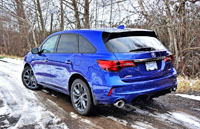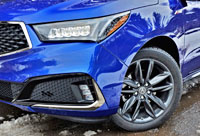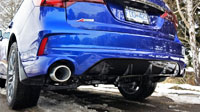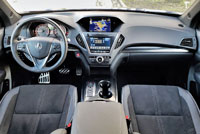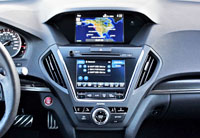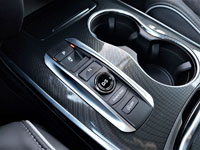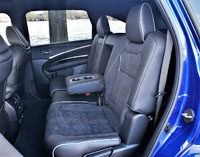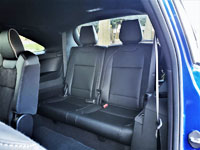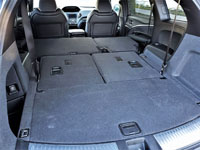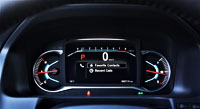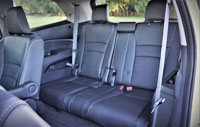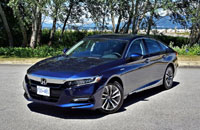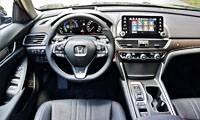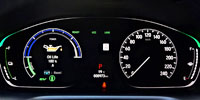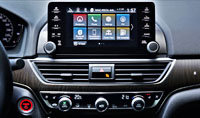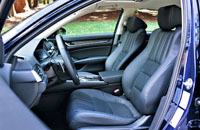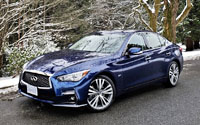
In a luxury car market that’s given up a lot to crossover SUVs, Infiniti’s Q50 has been more or less holding its own until recently. Canadian premium buyers were hard on BMW’s 3 Series and Audi’s A4 last year, with sales down 19.5 and 20.3 percent respectively, while others like Acura’s TLX, Cadillac’s ATS, and Jaguar’s XE lost even more ground, but the Q50 gained 6.8 percent throughout 2018, a fine showing by comparison.
This said, the first three months of 2019 have been brutal on all of the above including the Q50, with the Japanese sport-luxury sedan’s sales having fallen by 36.3 percent, a figure that looks about as bad as bad can get until compared to BMW’s 37.7 percent 3 Series losses and Audi’s 39.9 percent A4 carnage. Even the mighty Mercedes-Benz C-Class is down by 34.5 percent, while sales of the Lexus IS (which lost 10.9 percent last year) are now off by 45.5 percent, and Jaguar XE by 78.1 percent (its sales were only down 27.8 last year).
I should end this review right here, tell you to go check out my story on the impressive new Infiniti QX50 compact luxury SUV, and call it a day, but seriously, there were still 2,576 Q50 sedan buyers in Canada last year, and another 517 at the close of Q1 2019, so there are plenty of good reasons to review what I truly believe is a very good choice in the compact luxury D-segment, even if sport-luxury sedans aren’t exactly the hottest commodity these days.
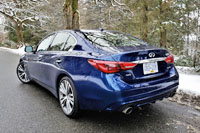
To bring you up to speed, Infiniti gave its only relevant sedan (they still make the Q70, but sales are truly dismal) a mid-cycle refresh last year, updating the Q50’s grille, front fascia, headlights, taillights, rear bumper and more, so this 2019 model doesn’t see any visual changes at all, other than a new Canadian-exclusive standard “I-LINE” cosmetic treatment specifically for the now renamed I-Line Red Sport 400 model.
Just like eyeliner, the I-Line upgrade, which was actually derived from “Inspired Line,” blackens the grille surround in the same fashion as last year’s glossy black fog lamp bezels and diffuser-style rear bumper, while the rear deck lid spoiler gets upgraded to high-gloss carbon fibre, and wheel wells are filled with a special “custom imported” glossy black set of 19-inch alloys. I-Line trim further helps to visually differentiate Infiniti’s sportiest 400-horsepower Q50 from lesser trims in the lineup, a smart move considering the $7,700 leap from the already quick 300 horsepower Q50 3.0T Sport AWD.
To clarify further, both 300 and 400 horsepower versions of the Q50 source their power from the same turbocharged 3.0-litre V6 engine in different states of tune, while the other big change for 2019 is the elimination of the Mercedes-Benz-sourced 2.0-litre four-cylinder engine in Canada, which continues to make 208 horsepower in other markets where it’s still offered, like the U.S.
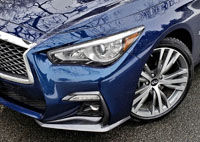
All remaining trims utilize Infiniti’s seven-speed automatic transmission with manual shift mode and downshift rev-matching, the latter a rarity in this class and really enjoyable to use, while Infiniti’s “Intelligent” rear-biased all-wheel drive system comes standard as well.
Fuel economy has improved since Infiniti moved to the new turbocharged 3.0-litre engine, although with the loss of the four-cylinder the base Q50 no longer wows with 10.7 L/100km in the city, 8.6 on the highway and 9.7 combined, although 12.4 city, 8.7 highway and 10.8 combined is very good considering all the power on tap.
All the above changes noted, the 2019 Q50’s most significant upgrade is the inclusion of Predictive Forward Collision Warning (PFCW) and Forward Emergency Braking (FEB) across the entire Q50 line, which means these critical accident avoidance systems are now part of the Luxe model, Luxe being the base trim level in the Q50’s recently revised grade structure.
Without going into too much detail about each trim, the Q50 3.0T Luxe AWD starts at $44,995 plus freight and fees, while the Q50 3.0T Signature Edition being reviewed here starts just a hair higher at $46,495. The upper mid-range of the lineup is filled by the aforementioned Q50 3.0T Sport AWD, which enters the picture at $48,495, and the newly revised I-Line Red Sport 400 that begins life at $56,195, which is still very affordable considering all that’s being offered.

All prices quoted in this review can be found in detail, along with trims, packages and options, right here at CarCostCanada, where you can also find important manufacturer rebate info and dealer invoice pricing that could save you thousands.
I said base a moment ago, but there’s nothing remotely base about the twin-turbo V6 behind the Q50’s trademark grille. For starters, none of its competitors offer 300 horsepower, or the direct-injected engine’s equally impressive 295 lb-ft of torque (well, almost equally impressive). I’ve waxed poetic about this engine before, not to mention gone on at length about the seven-speed autobox and AWD system it’s connected to, so rather than delve into the technologies that make them great I’ll give you more of an experiential explanation.
First off, it feels quicker than the numbers suggest, not that 300 ponies and 295 lb-ft of twist is anything to sneeze at. It simply has more jump off the line than most cars offering similar output, this likely due to its twin-turbos providing all of that torque from just 1,600 rpm all the way up to 5,200 rpm, which is much sooner than a normally aspirated engine would, and a very wide maximum torque band overall.
Amazingly, those turbos whirl at speeds of up to 240,000 rpm, something I have a hard time getting my mind around, especially considering their near silent operation and total reliability. Also notable, the lightweight mostly aluminum powerplant has been a Wards “10 Best Engines” winner since inception, just like its predecessors were, so it’s not just me singing its praises.
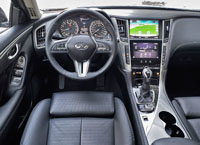
Press the ignition button on the instrument panel, toggle the “DRIVE MODE” switch on the lower console to select “SPORT” instead of “STANDARD” (SNOW, ECO and PERSONAL modes are also included), slot the leather-clad contrast-stitched gear lever into “D”, then tug it slightly to the left for manual mode, at which point you’d better prepare to shift the old fashioned way because steering wheel paddles can only be found on the 3.0T Sport and I-Line Sport 400. Not a problem. Certainly I’d love to find paddles all the way down the line, but the Signature Edition is a more luxury-oriented Q50 trim after all, despite its rapid acceleration and athletic agility through fast-paced turns.
The Signature Edition comes standard with the same 245/40R19 all-season run-flat performance tires as the Sport, but alas my tester was purposely shod in winters that no doubt affected lateral grip on dry patches. Then again, Infiniti didn’t skimp on the rubber, shoeing its standard triple-five-spoke alloys in a set of Pirelli Sottozeros that proved you don’t need an SUV to trudge through winter conditions effectively. In fact, it was so capable in wet West Coast snow that the Q50 became my go-to car for those soggy, cold winter weeks Vancouver is famous for, and a particularly enjoyable companion thanks to its quick reacting steering, agile suspension, and smooth, comfortable ride.
Some Signature Edition upgrades you might find interesting include the exact same performance-oriented exterior styling details as the Sport, including the sharper gloss black lip spoiler and deeper black fog lamp bezels up front, plus a less aggressive version of the black and body-colour diffuser-infused rear bumper cap mentioned earlier, while both models make use of the same more conventional silver-painted 19-inch alloy wheels noted a moment ago, which is an upgrade over the base Luxe model’s 18-inch rims on 225/50 all-season run-flat performance rubber.

Lastly, both trims receive silver “S” badges on the front fenders, but strangely the Signature Edition features a unique rear deck spoiler just above its own scripted “Signature” badge, whereas the Sport makes do with no rear spoiler at all, although it gets a silver “S” badge next to its Q50 nomenclature.
Inside, Signature Edition and Sport trims also feature the same Sport Type seats with driver-side powered lumbar support and powered torso bolsters, plus manual thigh extensions for both front occupants. The driver’s seat was incredibly comfortable while providing excellent lateral support, and honestly was another reason I chose the Q50 over some other options in my garage during my test week. Lastly, the surrounding decorative inlays in both Signature Edition and Sport models are finished in genuine Kacchu aluminum, which feels substantive and looks very nice.
So what separates Signature Edition and Sport trim? Most every other feature is shared with the base Q50 Luxe model, which is why there’s only $1,500 between the two trims. Therefore, along with all of the items already noted, the Q50 Signature Edition includes standard auto on/off LED headlights with LED daytime running lights, LED fog lamps and front turn signals, LED brake lights, aluminum “INFINITI” branded kick plates, proximity-sensing keyless entry, pushbutton ignition, Infiniti’s “InTuition” for storing climate, audio and driving preferences within each “Intelligent Key”, welcome lights on the front exterior door handles, rain-sensing wipers, an auto-dimming rearview mirror, a garage door opener, micro-filtered dual-zone auto climate control, Infiniti InTouch infotainment with a bright, clear 8.0-inch upper display and an equally impressive 7.0-inch lower touchscreen, a backup camera, Bluetooth phone and streaming audio, a nice sounding six-speaker AM/FM/CD/MP3/satellite audio system with HD playback, RDS and speed-sensitive volume, two USB charging ports, a heatable steering wheel (that really responded quickly), heated front seats (ditto), powered front seats, a powered moonroof, and more.
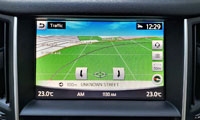
Of note, with the move up to the base V6 powerplant a number of features that were previously optional are now standard, including remote engine start, Infiniti’s accurate InTouch navigation with lane guidance and 3D building graphics, the Infiniti InTouch Services suite of digital alerts and remote services, voice recognition for audio, SMS text and vehicle info, power-adjustable lumbar support for the driver, and 60/40 split-folding rear seatbacks with a centre pass-through.
At the other end of the trim spectrum, the only real changes to previously noted Sport trim are actually performance oriented, such as those steering wheel-mounted paddle shifters I lamented about not having on the Signature Edition earlier, a unique sport-tuned dynamic digital suspension, and identical sport brakes to the Red Sport 400, which boast four-piston front calipers and two-piston rear calipers, while the two sportiest trims also get exclusive front seat-mounted side-impact supplemental airbags.
Speaking of features not available with this Signature Edition, only Sport trim gets the option of electronic power steering, while Infiniti’s exclusive drive-by-wire Direct Adaptive Steering (DAS) system is available on all trims except for the Signature Edition, as is the auto-leveling adaptive front lighting system (AFS) with high beam assist, a power-adjustable steering column with memory, an Around View Monitor (AVM) with Moving Object Detection (MOD), premium 16-speaker Bose Performance audio with Centerpoint technology, front and rear parking sensors, Intelligent Cruise Control with full speed range (ICC), Distance Control Assist (DCA), Blind Spot Warning (BSW), Blind Spot Intervention (BSI), Lane Departure Warning (LDW), Lane Departure Prevention (LDP) with Active Lane Control, and Backup Collision Intervention (BCI) with Cross Traffic Alert (CTA).
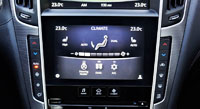
Features not available with the Signature Edition, optional with the Sport and standard with the Red Sport 400 include auto-dimming side mirrors with reverse link and memory, plus Infiniti’s Advanced Climate Control System with auto-recirculation, Plasmacluster air purifier and Grape Polyphenol Filter.
All of this places the Q50 Signature Edition in a unique value position, offering plenty of Sport trim features yet limiting its choice of options to colours, which are the same five offered in Sport trim including Liquid Platinum silver, Graphite Shadow grey, Black Obsidian, Majestic White, and my tester’s elegant Iridium Blue; plus interior themes, which just like the Sport can be had in Graphite (black) and Stone (grey). Incidentally, the base model also offers a Wheat (tan) interior, while dark-stained gloss maple hardwood provides a more traditional luxury ambiance, plus you also lose the option of Pure White or Mocha Almond (brown metallic) paint when moving up into the sportier Q50 trims, but you can’t get Iridium Blue, whereas Red Sport 400 buyers get the option of exclusive Dynamic Sunstone Red.
Along with the generous supply of features, the Q50’s interior is beautifully finished no matter the trim. My tester benefited from stitched leather right across the dash top, the instrument panel, each side of the lower console, and the upper two-thirds of all door panels, while the glove box lid was also soft to the touch. The finishing is excellent too, from that leather trim to the beautifully upholstered leather seats, to the lovely Kacchu aluminum inlays, the tasteful assortment of satin-silver accents, and other surfaces, while all of the switchgear feels substantive, is nicely damped, and fits together snuggly.
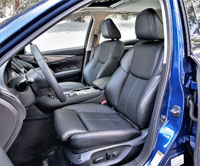
Likewise, the Q50 is wonderfully hushed inside, whether touring around city streets or cruising the highway, and it’s certainly roomy enough. Bringing more size to the value equation has being part of Infiniti’s modus operandi since day one, and it results in a near mid-size competitor that offers a more spacious interior then some D-segment rivals. I’m only five-foot-eight with a smaller build, and despite having longer legs than torso, which can sometimes make it difficult to reach the steering wheel comfortably, even when its telescopic reach is extended as far rearward as possible, I found its adjustability excellent and the resultant driving position ideal. There’s so much seat travel and headroom that it should be good for taller folk too, while the adjustable torso, lumbar and thigh support really added support to my backside and comfort below the knees.
For testing purposes I slipped into the back seat directly behind the driver’s seat, and found more than enough room to be comfortable too. Specifically, I had about five inches ahead of my knees, plenty of room to put my big winter boots under the driver’s seat, and more than enough space from side to side, while there was also about three inches over my head. The rear quarters are just as nicely finished as those up front, with amenities including a folding centre armrest with integrated cupholders, reading lights overhead, and air vents on the backside of the front console.
The trunk should sizable enough for most owners’ needs, but at 382 litres (13.5 cubic feet) it’s certainly not anywhere near the largest in the class. Also, its standard 60/40 split-folding rear seatbacks aren’t as flexible as the usual European 40/20/40 division, but Infiniti compensates with a centre pass-through that provides almost as much room for loading longer items such as skis down the middle while rear passengers enjoy the more comfortable outboard window seats, a real bonus with active lifestyle families.

Yes, the Q50 could be a bit better here and there, but this is also the case for every car it competes against. Fortunately its value proposition, excellent reliability record, impressive interior, handsome styling, and superb performance solidly make up for this one downside. After all, if you need more trunk space and greater passenger/cargo flexibility Infiniti has a QX50 you’d probably enjoy just as much, not to mention a QX60, QX80 and others. If you’re dead set on buying a sport-luxury sedan, you could do a lot worse than this new Q50 Signature Edition or one of its other impressive trims.
Story credit: Trevor Hofmann
Photo credits: Karen Tuggay


